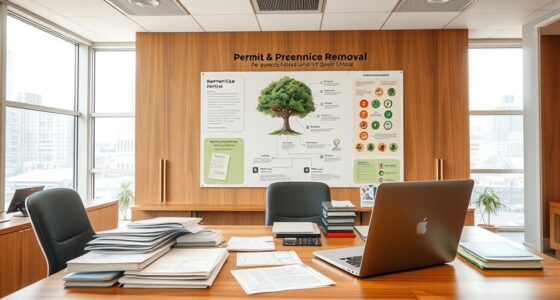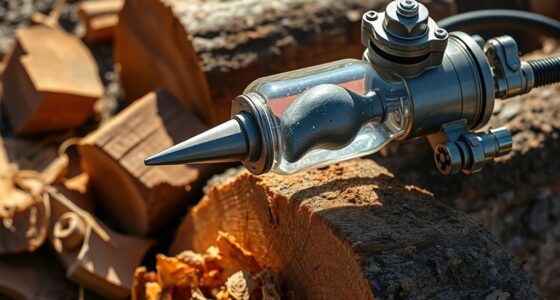If you want the easiest woods to split, focus on soft, straight-grained species like soft maple, basswood, and eastern red cedar. Ponderosa pine, aspen, and yellow poplar are also great choices because they’re lightweight, soft, and have uniform grain patterns. These woods require less effort and are forgiving for beginners. Keep in mind, moisture content and proper technique matter—continue exploring to discover how to make your splitting projects even smoother.
Key Takeaways
- Soft Maple, Basswood, Ponderosa Pine, Eastern Red Cedar, Aspen, and Yellow Poplar are among the easiest woods to split.
- These species have straight, uniform grain patterns that facilitate clean and effortless splitting.
- Proper moisture content and seasoning are crucial for reducing resistance and preventing cracking.
- Softness and low density of these woods make them ideal for beginners and quick projects.
- Controlling moisture and using sharp tools aligned with the grain enhance splitting ease and safety.
Soft Maple
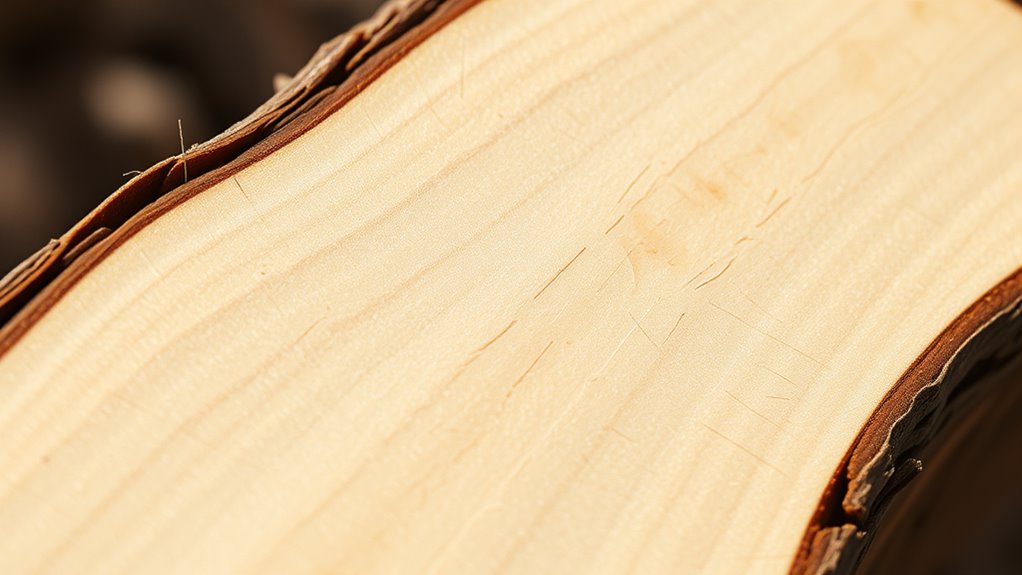
Have you ever noticed how soft maple trees stand out with their delicate, light-colored wood? Its grain pattern is usually straight and uniform, making it easy to work with and visually appealing. It is also characterized by its low density, which contributes to its ease of splitting and shaping. Due to its lightweight nature, soft maple is especially favored for projects requiring less weight and easier handling. The moisture content in soft maple is essential; when properly dried, it becomes less prone to warping or splitting. Properly managing moisture content ensures you get a smooth, easy splitting experience, highlighting its qualities as one of the easiest woods to work with. Additionally, understanding the wood properties can significantly influence how easily it splits and shapes. Recognizing how moisture levels impact wood behavior can further facilitate successful projects with soft maple.
Basswood

Did you know that basswood is prized for its softness and smooth texture? Its grain pattern is fine and even, making it easier to split. When working with basswood, pay attention to its moisture content, as lower levels help it split more cleanly. Additionally, understanding the grain pattern can significantly improve splitting efficiency. Here are some key points:
Basswood’s fine grain and moisture control make splitting easier and cleaner.
- The grain pattern is straight and uniform, reducing resistance during splitting.
- A moderate moisture content ensures the wood is not too brittle or too wet.
- Its soft nature minimizes the effort needed to split it.
- Consistent moisture levels help prevent cracking or warping.
Ponderosa Pine
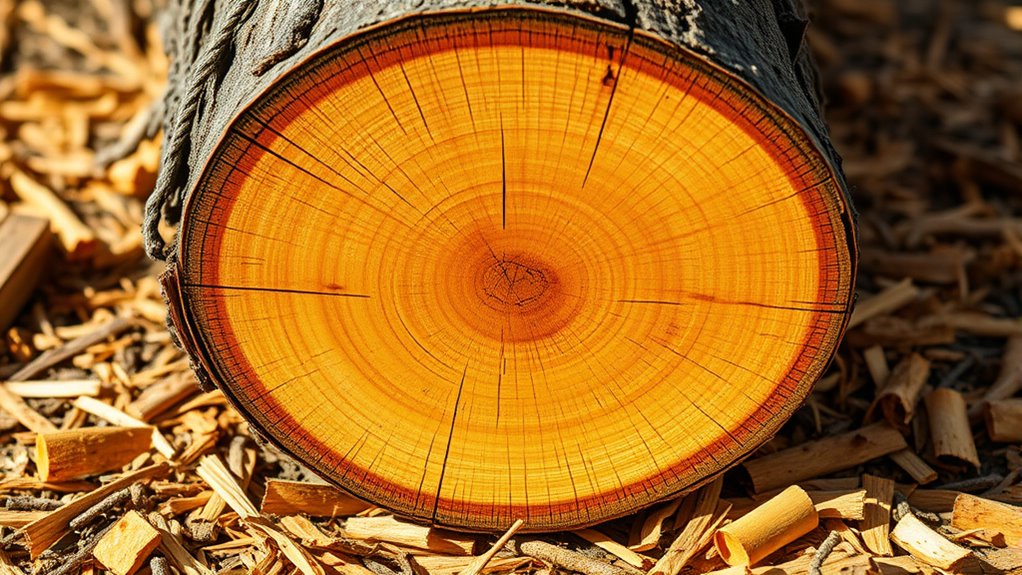
Ponderosa Pine is known for its strength and versatility, making it a popular choice for construction and woodworking projects. Its grain pattern is generally straight, which helps with splitting and shaping the wood easily. The grain’s uniformity reduces resistance when splitting, making it a practical option for DIYers. Additionally, Ponderosa Pine has a relatively low moisture content when properly dried, which minimizes warping and cracking. This stability further simplifies the splitting process, allowing you to work more efficiently. Its light weight and ease of handling make it ideal for projects requiring manageable logs. Overall, the combination of a straight grain pattern and controlled moisture content makes Ponderosa Pine one of the easiest woods to split, especially for beginners.
Eastern Red Cedar
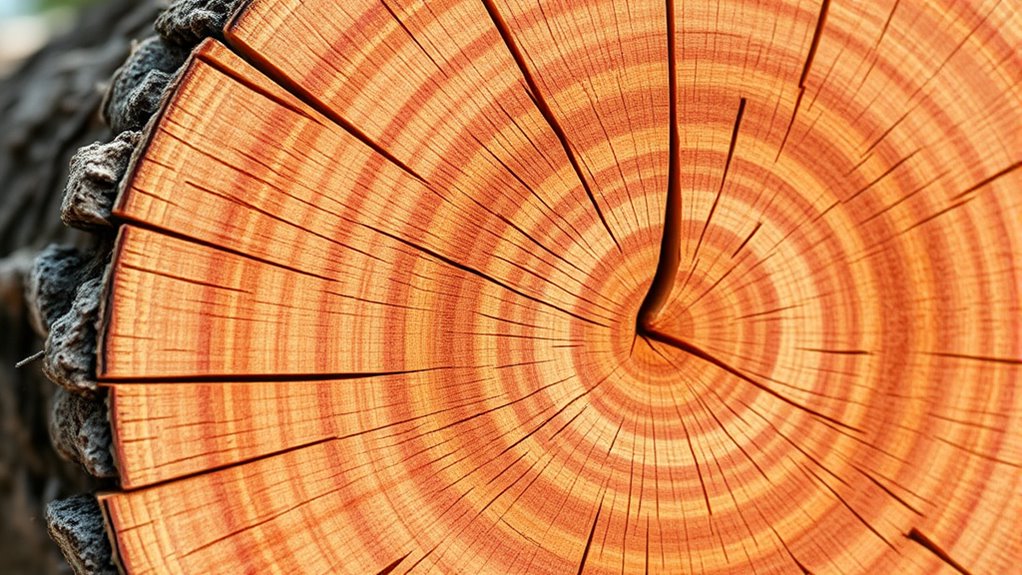
Is Eastern Red Cedar one of the easiest woods to work with? Absolutely. Its low moisture content makes it ideal for splitting, as it dries quickly and reduces warping. The grain pattern is straight and uniform, which helps when you’re aiming for clean splits. Here are some key points:
- The low moisture content means less resistance when splitting.
- Its straight grain pattern allows for smoother, more predictable splits.
- The wood’s softness makes it easier to handle with hand tools.
- Its lightweight nature reduces fatigue during work.
Because of these features, Eastern Red Cedar is forgiving and user-friendly, especially for beginners. Its ease of splitting combined with attractive appearance makes it a popular choice for various projects.
Aspen
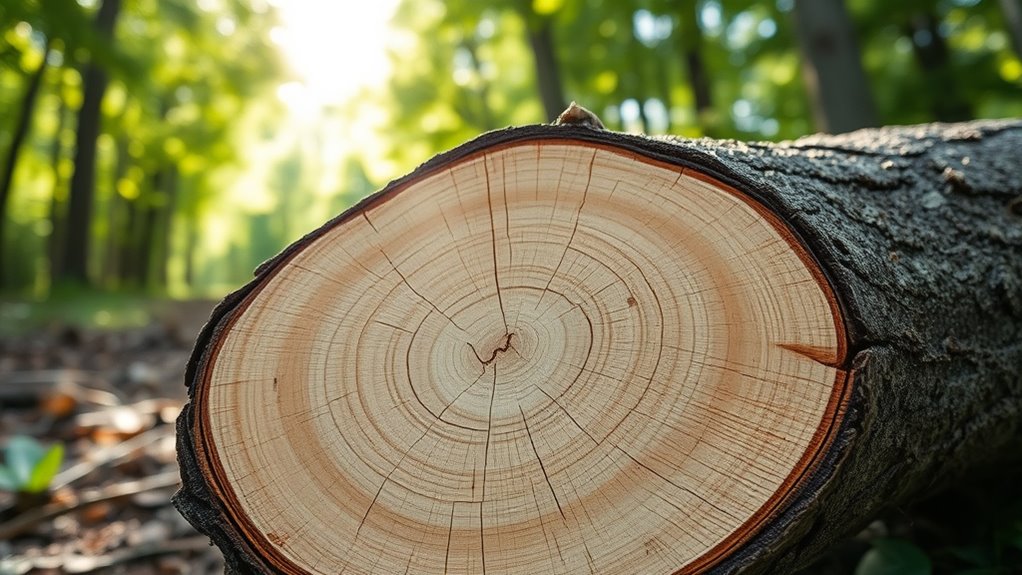
Have you ever worked with Aspen wood? Its straight, uniform wood grain makes it one of the easiest woods to split. When splitting Aspen, use sharp tools to follow the wood grain carefully, reducing the chance of splitting errors. Applying a bit of leverage along the grain helps you split pieces smoothly and efficiently. Aspen’s softness means it doesn’t resist your efforts, making your job easier. For best results, start with a clean, well-placed strike and work with the natural grain direction. Avoid forcing splits against knots or irregularities, as this can cause the wood to crack unpredictably. With the right splitting techniques, Aspen becomes a forgiving material, perfect for quick projects and beginners. Its lightweight, easy-to-handle nature makes it a favorite for simple woodworking tasks.
Yellow Poplar
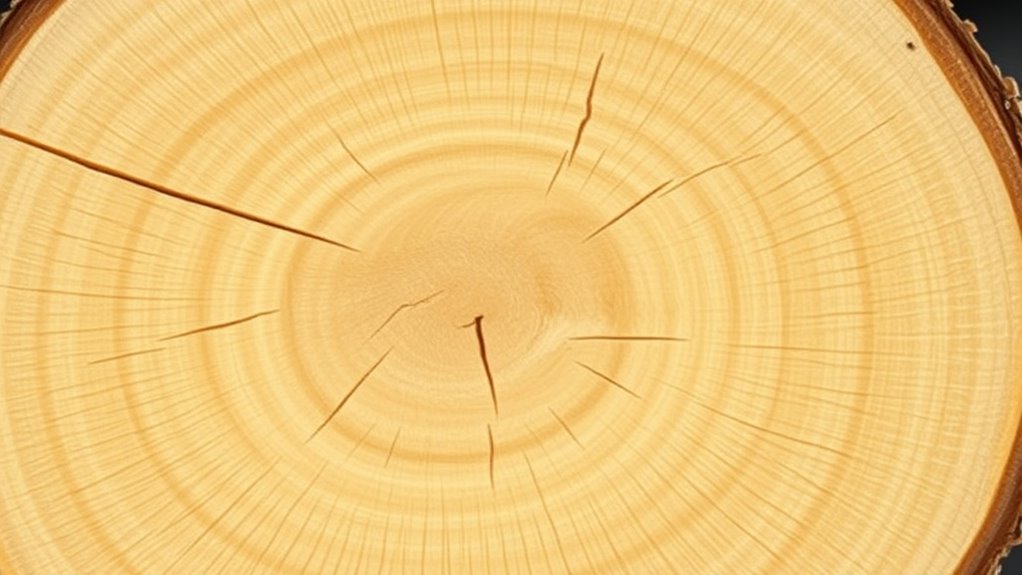
Did you know that Yellow Poplar, also known as Tulip Tree, is one of the most versatile and easy-to-work-with woods? Its grain patterns are straight and uniform, making splitting straightforward. The manageable moisture content ensures it doesn’t warp or crack easily. When working with Yellow Poplar, keep these points in mind:
- Its consistent grain simplifies splitting efforts.
- Low moisture content helps prevent splitting issues.
- The wood’s softness reduces the force needed.
- Proper drying enhances its split-ability further.
- Its reputation as an amazing life together material underscores its reliability and ease of use for various projects. Additionally, understanding the properties of wood can help you select the best species for your specific needs.
A woodworking approach that considers the species’ characteristics will yield the best results. This species is ideal for projects requiring easy splitting because its grain patterns promote smooth splits. Its moisture content, when well-maintained, ensures predictable results. Furthermore, wood properties such as grain structure influence how easily a wood can be split. Recognizing the impact of moisture on wood stability is crucial for optimal results. Overall, Yellow Poplar is a reliable choice if you want a wood that’s simple to work with and splits with minimal effort.
Eastern White Pine
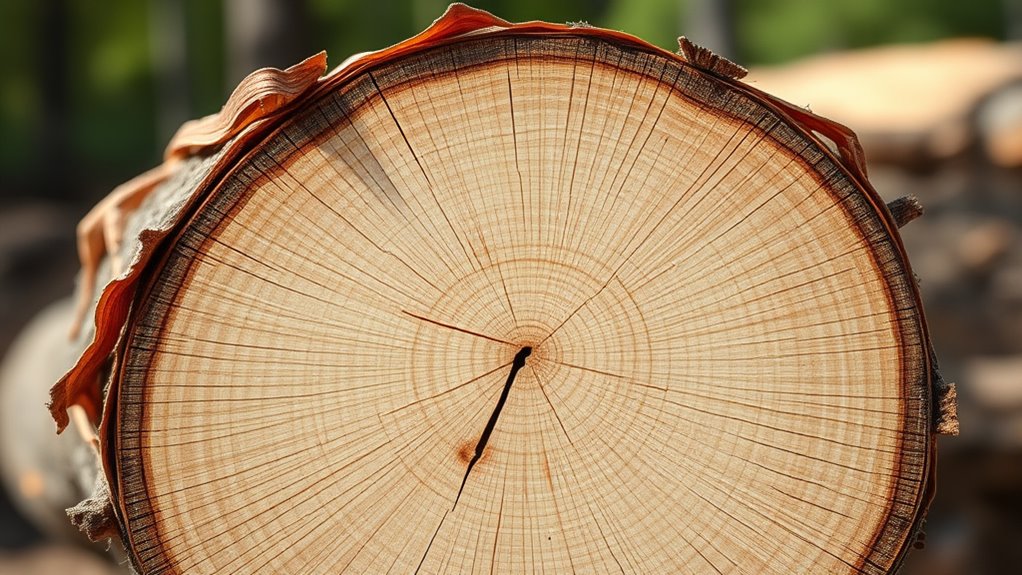
Eastern White Pine has gentle splitting properties, making it easy to work with. It’s lightweight and soft, which helps reduce fatigue during projects. Plus, its easy tool penetration means you can cut and shape it with less effort. Demonstrating proper problem-solving abilities can also make working with this wood more efficient. Additionally, its favorable fiber content contributes to its ease of splitting and shaping.
Gentle Splitting Properties
The Eastern White Pine is renowned for its gentle splitting properties, making it an excellent choice for woodworking projects that require clean, controlled splits. Its grain pattern runs straight and uniform, easing the splitting process. Maintaining ideal moisture content, around 12-15%, is key to achieving smooth splits without warping. To get the best results, keep these points in mind:
- Ensure the wood isn’t too wet or dry, as improper moisture levels hinder splitting.
- Follow the grain pattern for cleaner, more predictable splits.
- Work with seasoned wood for easier handling and better control.
- Apply steady, even force to prevent chipping or splitting along unintended lines.
- Using proper tools can significantly improve the ease and safety of the splitting process.
- Properly managing the vibrational energy during splitting can also facilitate smoother and more precise results.
- Additionally, understanding the wood’s natural properties helps in selecting the right splitting techniques for different types of wood.
- Being aware of the moisture content ensures optimal splitting conditions and reduces the risk of warping or cracking.
- Incorporating controlled splitting techniques can further enhance the quality and safety of your woodworking projects.
Lightweight and Soft
Despite its softness, Eastern White Pine remains a popular choice for many woodworking projects because of its lightweight nature. Its grain pattern is relatively straight and uniform, making it easy to work with and ideal for beginners. The wood’s low moisture content contributes to its lightweight feel, reducing the effort needed to handle and split. This softness allows you to make clean cuts without much resistance, simplifying the splitting process. Eastern White Pine’s low density also means it’s less likely to warp or crack over time. Because it absorbs moisture easily, controlling its moisture content ensures stability and prevents splitting issues later. Additionally, wood properties such as its low density and ease of splitting make it especially suitable for novice woodworkers. Overall, its combination of softness, manageable grain pattern, and moisture adaptability makes it a top pick for projects requiring easy splitting and handling. For optimal results, understanding the wood’s moisture content can help prevent unexpected cracking during the splitting process.
Easy Tool Penetration
Because of its soft, low-density structure, Eastern White Pine allows tools to penetrate easily with minimal effort. Its grain orientation runs mostly parallel to the trunk, creating less resistance and smoother cuts. To optimize tool penetration, consider these factors:
- Keep the moisture content low; drier wood is easier to split and cut.
- Align your tools with the grain to reduce splitting resistance.
- Use sharp blades or bits to minimize force needed.
- Avoid working on knots or sections with irregular grain, which can resist penetration.
- Properly prepared and conditioned wood can further enhance ease of splitting and cutting, especially when considering factors like lifestyle and workspace setup.
- Using appropriate safety equipment can prevent accidents and improve control during splitting and cutting.
Douglas Fir

Have you ever wondered why Douglas Fir is such a popular choice for lumber and landscaping? Its appealing grain patterns add visual interest, making it a favorite for both structural and decorative projects. Douglas Fir has a moderate moisture content that helps it split easily, especially when properly seasoned. This wood isn’t overly dense, which means it responds well to splitting without excessive effort. The grain tends to be straight with some knots, providing a predictable split path. Its stability and strength make it ideal for construction, but it’s also manageable enough for DIY projects. When working with Douglas Fir, controlling moisture content is key—aim for adequately dried wood to ensure easier splitting and better overall workability.
Balsa Wood
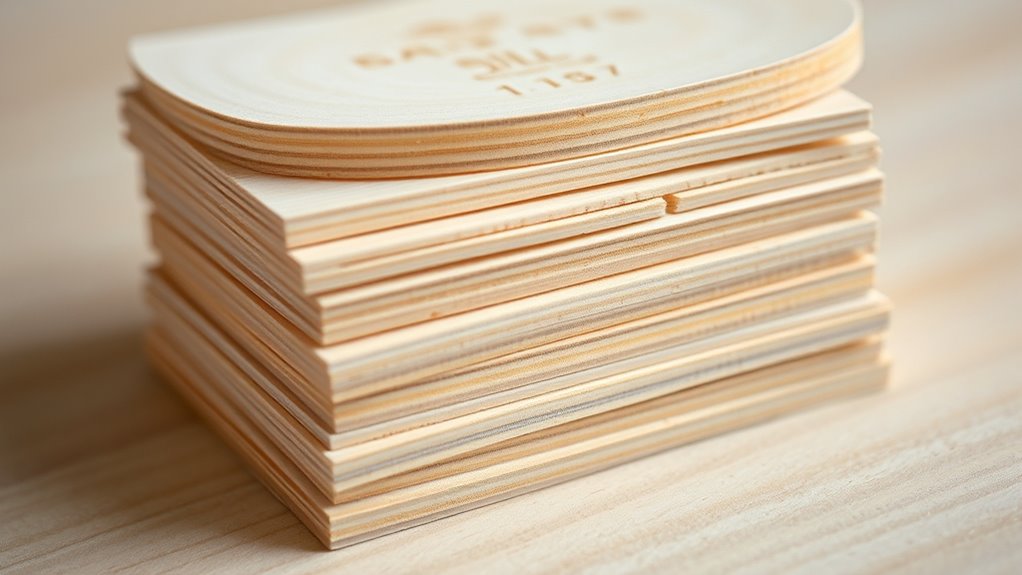
Ever wondered what makes Balsa wood stand out among other lightweight woods? Its unique combination of low moisture content and distinctive grain pattern makes it incredibly easy to split. Here’s what sets it apart:
- The grain pattern is loose and straight, reducing resistance when splitting.
- Its moisture content is typically low, which prevents warping and makes it more manageable.
- The wood’s soft texture means less effort is needed to break it apart.
- Its lightweight nature ensures you won’t struggle with heavy, dense materials during splitting.
Because of these features, Balsa wood is perfect for quick, clean splits. Whether you’re crafting or working on a project, its ease of use saves time and effort, making it one of the easiest woods to split.
Frequently Asked Questions
Which Wood Types Are Best for Beginner Woodworking Projects?
When starting woodworking projects, choose woods with lower density for easier cutting and shaping. Softwoods like pine, cedar, and basswood are ideal because they typically have shorter curing times, making them less prone to warping or cracking. These woods are forgiving for beginners, allowing you to learn basic techniques without frustration. As you gain experience, you can explore denser woods, but starting with softer options helps build confidence and skill quickly.
How Does Moisture Content Affect Wood Splitting Ease?
You’ll notice that moisture level greatly impacts how easily you can split wood. If the wood has a high moisture content, it’s tougher to split because the fibers are more flexible and resilient. During the drying process, reducing moisture makes the wood more brittle, easing splitting. Properly dried wood with a low moisture content is ideal, as it’s easier to work with and less likely to crack or deform during splitting.
Are Softer Woods More Prone to Splitting During Construction?
Softer woods are generally more prone to splitting during construction because they have lower wood density, making them easier to fracture with the right splitting techniques. When you work with soft woods, use controlled force and proper wedges to prevent excessive splitting or damage. Soft woods respond well to splitting, but you should still be cautious to maintain control and guarantee clean, safe splits during your project.
What Safety Precautions Should I Take When Splitting Wood?
Did you know that improper safety precautions cause many wood-splitting injuries each year? When splitting wood, always wear safety gear like gloves, goggles, and sturdy boots to protect yourself. Use proper splitting techniques—like keeping a firm stance and controlled strikes—to avoid accidents. Keep your work area clear of debris and make sure your tools are in good condition. Taking these steps helps you stay safe and makes splitting wood more efficient.
How Does Wood Grain Influence Splitting Difficulty?
Wood grain markedly influences splitting difficulty. If you notice a straight grain pattern, you’ll find it easier to split because the fibers run parallel, allowing the axe to follow the grain smoothly. However, knot presence complicates splitting, as knots disrupt the grain’s uniformity, making the wood harder to split and increasing the risk of the axe bouncing or getting stuck. Paying attention to these factors helps you split wood more effectively.
Conclusion
Now that you’ve seen the easiest woods to split, imagine what you could create with them. Picture the crack of soft wood giving way beneath your hands, revealing endless possibilities. Will you choose the gentle basswood or the resilient ponderosa pine? Each piece holds a secret waiting to be uncovered. The choice is yours—dive in and discover the satisfaction of working with the perfect wood, just within reach, ready to surprise you.



